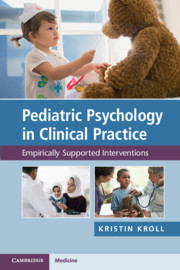Book contents
- Pediatric Psychology in Clinical Practice
- Pediatric Psychology in Clinical Practice
- Copyright page
- Dedication
- Contents
- Chapter 1 Introduction to Pediatric Psychological Care
- Chapter 2 Working with Young Children with Medical Concerns
- Chapter 3 Working with School-Age Children with Medical Concerns
- Chapter 4 Working with Adolescents with Medical Concerns
- Chapter 5 Chronic Illness and the Family Unit
- Chapter 6 Psychological Guidelines for Specific Medical Conditions
- Chapter 7 Special Populations in Pediatric Psychology
- Chapter 8 Technological Applications and Pediatric Psychological Care
- Index
- References
Chapter 8 - Technological Applications and Pediatric Psychological Care
Published online by Cambridge University Press: 18 January 2020
- Pediatric Psychology in Clinical Practice
- Pediatric Psychology in Clinical Practice
- Copyright page
- Dedication
- Contents
- Chapter 1 Introduction to Pediatric Psychological Care
- Chapter 2 Working with Young Children with Medical Concerns
- Chapter 3 Working with School-Age Children with Medical Concerns
- Chapter 4 Working with Adolescents with Medical Concerns
- Chapter 5 Chronic Illness and the Family Unit
- Chapter 6 Psychological Guidelines for Specific Medical Conditions
- Chapter 7 Special Populations in Pediatric Psychology
- Chapter 8 Technological Applications and Pediatric Psychological Care
- Index
- References
Summary
This chapter focuses on describing the increasingly pervasive use of technology in mental health care. The current research on the types of telepsychological interventions being utilized in mental health care today is discussed, in conjunction with a review of the efficaciousness of these interventions, current state regulations, and the ethical considerations that arise with this modality of intervention. The reader is then introduced to barriers to and solutions for the practical implementation of telepsychological services in their workplace. Readers are also provided with recommended technological resources and implementation guidelines for incorporating telemental health practices into clinical work with children and adolescents with medical problems, as well as recommended phone applications can be utilized in pediatric psychology practice.
- Type
- Chapter
- Information
- Pediatric Psychology in Clinical PracticeEmpirically Supported Interventions, pp. 164 - 176Publisher: Cambridge University PressPrint publication year: 2020

